Diary of an Escaped Sex Slave
She was forced to have sex with hundreds of men before she turned 10. After such a brutal past, what does her future hold? In a Marie Claire exclusive, Sreypov Chan tells her phenomenal life story.
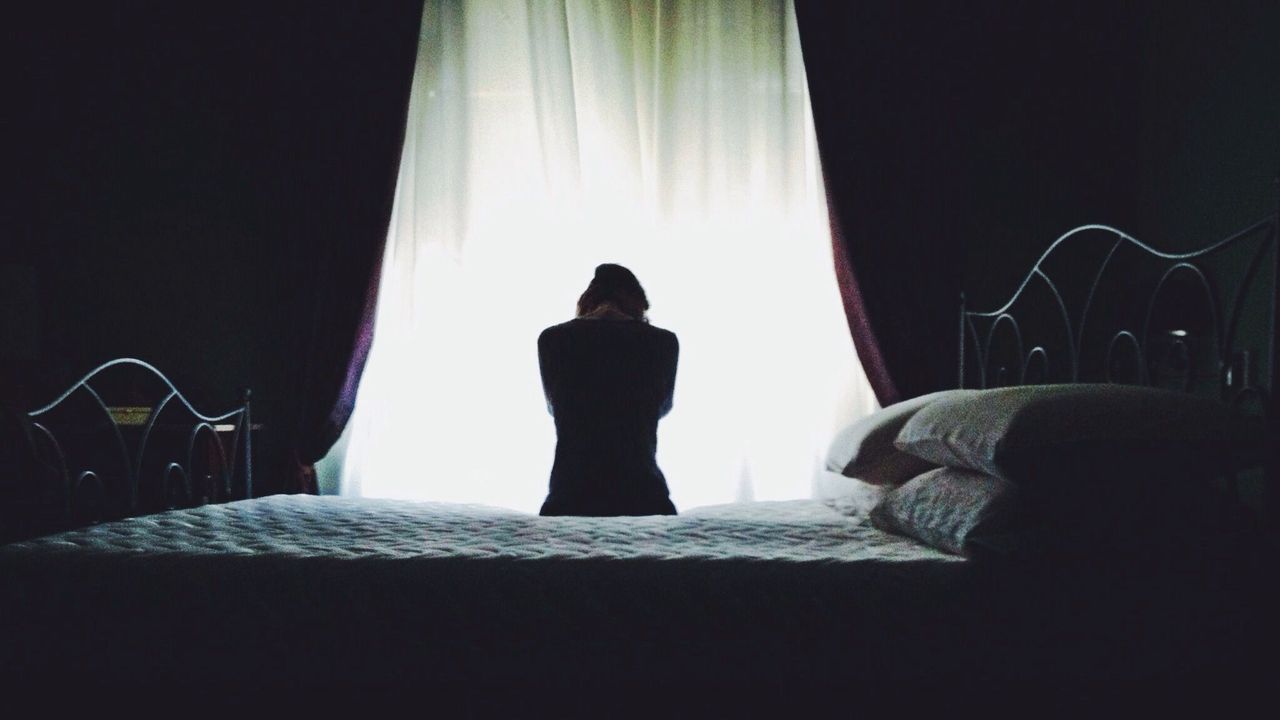
Sreypov Chan, a young Cambodian woman with a feisty laugh and a love of Kelly Clarkson songs, has a recurring dream: She's being chased by gangsters. They catch her and throw her into a filthy, cockroach-infested room. She knows what will happen next: She will be tortured—whipped with metal cables, locked in a cage, shocked with a loose electrical wire—and then gang raped.
Sreypov has lived this dream.
When she was 7 years old—an age when most girls are going to slumber parties—she was sold to a brothel in Phnom Penh, Cambodia's capital city, to work as a sex slave. The woman who made the sale: her mother.
For years, pimps forced Sreypov to have sex with as many as 20 men a day. If she didn't meet her quota, or if she tried to run away, she was punished in unthinkable ways—burned with a hot poker, covered with biting insects. And worse. "I wanted to die," she says.
Sreypov is among the lucky ones. At age 10, she managed to break free of the brothels and start a new life. Today, she's ready to tell her story, talking openly about her enslavement and escape, and about coming to terms with her dark past.
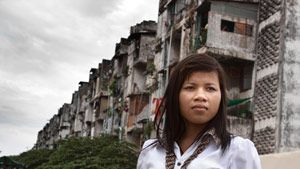
As shocking as Sreypov's tale is, she's not alone. More than 12 million people are now victims of forced prostitution and labor across the world. The buying and selling of humans is a $32 billion global business, according to the U.S. State Department's 2009 Trafficking in Persons Report.
What kind of person sells her own daughter into slavery? In Cambodia, a deeply poor, corrupt nation still reeling from the bloody genocide perpetrated by the Khmer Rouge regime in the '70s, it's someone especially desperate.
Stay In The Know
Get exclusive access to fashion and beauty trends, hot-off-the-press celebrity news, and more.
I first met Sreypov three years ago when she visited the U.S.—her first trip out of Cambodia. Seventeen years old at the time, she was so shy, she could barely look up at the people she met. "Sreypov can't believe how friendly people are to her here," one of her travel companions explained. "They look her in the eye."
A year later, I met Sreypov again. A smiling, chubby-cheeked 18-year-old, she greeted me with a giant hug and giggled out a "Hello, how are you?" in her freshly learned English. In her shiny pink raw-silk dress, she looked as if she'd discovered she had the right to exist. Still I wondered: Could she ever really get over her painful past? This year, I traveled to Cambodia to find out.
From the air, Cambodia looks like it's drowning in mud. It's monsoon season, and we swoop through coal-black clouds, then hit the runway in Phnom Penh with a jarring boom. On the ground, my taxi plows through flooded roads that are more like rivers, clogged with motorized rickshaws.
Down a narrow dirt lane in the middle of the city, up a winding flight of stairs, Sreypov, now a sparkly young woman of 20, sits in the room where she lives. The walls are mostly bare, except for a big green plastic clothes-hook in the shape of a smiling bug. A Tom and Jerry comforter tops her bed; there's a framed photo on her desk showing friends on a motorbike, including a girl missing an eye. I learn that a pimp gouged out the girl's eye with a piece of metal when she dared to ask for a rest from clients after an abortion.
Sreypov sits on her bed and begins her life story, with the help of a translator named Chanthan Roeurn. She says she remembers a happy childhood, with loving parents, five siblings, and a house in the rural district of Koh Thom, where her family owned a rice field. "You need to get an education," Sreypov recalls her father saying. She pictured herself going to school one day.
When she was 5, her father died. "After that, my mother changed," Sreypov says. "She was terribly unhappy; all the love drained out of our lives. We became very poor." The family eventually moved to a shack. When Sreypov was 7, her mother sold her, telling her she would be working as a housekeeper in another home. Sreypov felt it was her duty to obey. In Cambodia, Chanthan explains, "Daughters are like property: They are there to provide for the family."
Indeed, Sreypov did do a little housecleaning—for two days. On the second evening, her new employers drove her to another home, in Phnom Penh, where she ate dinner and went to bed. "When I woke up, I couldn't get out," she says. "I was locked in the room. I was crying, trying to open the door." Sreypov's demeanor visibly changes at the memory, her usually warm, animated face turning serious, then expressionless. It was her first night in a brothel.
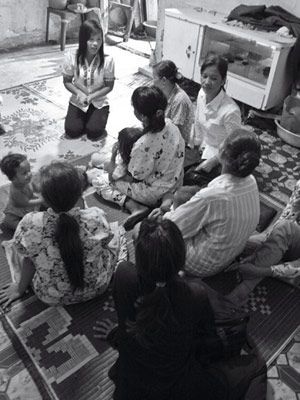
The road to Kampong Cham, a town about two hours outside Phnom Penh, is a bumpy one; punishing rains have left the dirt thoroughfare dented with colossal potholes. Sreypov, Chanthan, and I are on our way to a center for rescued sex slaves. Sreypov, who once stayed at the center herself, returns often to talk with the girls, all of whom are under age 18. Some are as young as 5.
As we bounce along, we pass oxcarts, open-air homes on stilts, bony goats, and naked kids playing close to the road. A puppy bounds out in front of our car; with no time to maneuver, we hit it with a thud, leaving it dead in the road.
At the center, called AFESIP (an acronym for its French name), several dozen girls are getting a lesson in hygiene from a nurse. When the class breaks up, the girls, dressed in their public-school uniforms—white cotton blouses, knee-length blue skirts—excitedly swarm around Sreypov, practically tackling her to the ground. The girls live at the center, which is run by a former victim of sex slavery named Somaly Mam, and attend a nearby school, as well as learn job skills like sewing and hairstyling.
Sitting on a metal swing with Chanthan on the grassy grounds of the center, Sreypov continues her tale. "At first, it was quiet," she says, recalling her initial days in the brothel. "Then one day, a man opened the door and said, 'Do you want a client?' I didn't know what he meant, but I knew it was bad. I said no. Then he brought me to a room for punishment." She pauses for a moment. "I had to drink the man's urine." The abuses escalated in the following days. She was tied up and covered with biting ants, whipped with an electric cable. Finally, she said yes.
Sreypov stares off into the distance, awaiting the next question. She is uneasy telling her story; it doesn't tumble forth freely, but rather comes in short, staccato, emotionless bursts. It's as if she becomes someone else to cope with recounting her own past.
When Sreypov saw her first client—"an Asian man with a cruel look in his eyes," she recalls—she changed her mind and said no again, and started to cry. Furious at her behavior, the pimp took his abuse to a new level, crushing up a handful of hot chili peppers with his foot and stuffing them in her vagina. Then he took a hot metal rod and jammed it inside her as well. "The pain was so terrible," she says. "I couldn't speak." Soon after, the client raped her.
Sreypov doesn't know if the client paid a high fee for her virginity; she never saw any money at the brothel. In general, sex with girls can cost as little as $5 (that's less than the $9 I paid to take a taxi from the airport to my hotel), but virgins usually command a far higher price. Clients can pay as much as $800 to $4000, according to the Trafficking in Persons Report. And virgins can fetch that price more than once, as the pimps often stitch up the girls (without an anesthetic) after the first time they have sex, so they'll scream in pain the next time, tricking clients.
After Sreypov's initiation into sex slavery, she spent the next few months imprisoned in her room, with a guard stationed at the door. If she didn't meet her quota of men for the day, she would be shocked with a loose wire from a socket in the wall. "On some days, I was so tired, I couldn't get out of bed. The men would just come to my bed, one after another, like a gang rape," she says. "I became numb. My life grew dark. I thought everything was finished for me."
Sreypov sits silently for a moment. Her eyes, distant a few moments earlier, now seem deeply sad. Chanthan looks over at me; then, as if to explain Sreypov's past, she sighs and says simply, "This is Cambodia." Chanthan, like many here, blames the country's problems on the Khmer Rouge, which tortured and executed as many as 2 million teachers, lawyers, doctors, and city dwellers—about a third of the population—during the '70s, in an attempt to turn the country into a purely agrarian society.
It's late afternoon, and we rejoin the girls in the center to say good-bye. They're entertaining themselves by doing a traditional Cambodian dance, with the older girls teaching the younger ones—among them, Sreypov's 8-year-old sister, Opekha. The girl is mentally disabled, but Sreypov was afraid her mother would try to sell Opekha anyway, so she brought her here. When we try to leave, the girls don't want to let us go. Even though they've just met me, they hug me, tightly. A pretty Vietnamese teenager whispers to me, "Promise you will never forget me."
That evening in the car, I sit in the backseat next to a tiny girl named Sreymach, who was sold as a sex slave a year ago, at age 5. She stares, wide-eyed, out the window as we hit the outskirts of Phnom Penh, its hotels and bars gleaming in the night. She is traveling to the city to visit a health clinic. She has HIV.Phnom Penh's most notorious sex district is called the White Building, so named for an ominous, decaying, grayish-white structure that stretches over several city blocks. Its tenants are sex workers, many of whom have been booted from smaller brothels because they're either too old—in their teens and 20s—or too sick to be of much use anymore. With no education or job skills, they've had to find new pimps here.
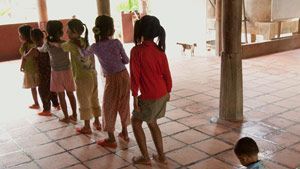
We walk down the street in the shadow of the gloomy building, past vendors selling bright-yellow jackfruit, bike parts, dried nuts. All eyes are on us. A man on a motorbike trails our group a little too closely, watching. Sreypov is here to try to help women escape the sex trade. It's part of a job she took with Somaly's organization, after a job at a local clothing factory didn't work out so well (she worked for seven months there, but received pay for only three). In her backpack, she carries boxes of condoms and soap to give to the sex workers—which is why the pimps let her in. Her face looks remarkably calm for someone who is about to step into a reminder of her nightmarish past.
Down a dim corridor on the ground floor of the White Building, a dozen women have gathered in a cramped room, along with a few of their kids. An ancient relic of a TV blares cartoons. In a sleeping loft overhead, the walls are lined with posters of Thai movie stars and photos of mansions—inconceivable aspirations considering the conditions in this room, where perhaps a dozen women sleep. It's around 10 a.m. and the women are wearing pajamas and earrings, resting from the night's work. They look beaten up. Their garish evening dresses hang in the bathroom, beside a door frame that's been decimated by termites.
Sreypov, in a crisp white cotton button-down blouse, black pants, and white heels with sparkling silver trim, kneels on the floor as the women circle round. Sitting there, with her perfect posture, she looks like hope personified. When she introduces herself and describes her past, a man peers into the doorway. Then another.
Undaunted, Sreypov continues, inviting the women to talk about their problems. A painfully thin young woman with high cheekbones, long legs, and hair swept up in a loose knot says she was approached one night by a group of men. Afraid they would gang rape her, she sought help from a man driving by in a car. He opened the door and let her in, but then later raped her himself. Another woman in pink pj's says her stepfather raped her, then sold her to a brothel.
Sreypov says she understands—she was sold, too. Then she tells the women she can help them get trained for other jobs. The first woman is skeptical. She has kids and doesn't think a job as a seamstress will pay the bills. Sreypov tells her it's worth a try, adding, "My own future has changed." Later, she hands out boxes of condoms; a toddler neatly stacks them up.
It's hard to imagine why men would want to have sex in a place like this. It's joyless, grimy, dangerous. The reasons vary: Some local men believe myths that sex with a virgin brings luck or good health; foreigners are usually pedophiles or men who want to play out violent fantasies they've picked up from porn films. They know they can do so in Cambodia. Prostitution and human trafficking are illegal here, but officials are often paid to look the other way.
Our White Building visit continues in another sweltering room on the second floor. Sreypov and her colleagues pile their shoes at the door, a futile gesture of politeness and cleanliness in a room where the walls are splattered with stains and the hallway is littered with chicken bones and rotten vegetable scraps. The women here look younger and prettier than the ones downstairs. "They have foreign clients," Chanthan explains. "Some are married, but their husbands are their pimps." In contrast, the women we met in the previous room service local clients.
After Sreypov's initiation into sex slavery, she spent the next few months imprisoned in her room.
The mysterious man who followed us on the motorbike pokes his head in and stares—a pimp, perhaps? The women sit on the floor with their babies on their laps; one young mother eats noodles from a bowl. A teenager in a floral cotton top says she didn't have any clients last night and needs money. Another young woman with glittery purple fingernails and an ankle bracelet says she finds her foreign clients in restaurants. Sreypov listens and nods; she hopes that by developing a relationship with these women, they will eventually enlist her help to break free. If so, her colleagues would work with the authorities on a rescue mission or raid. It's a risky business, to be sure. Sreypov knows the dangers of angering pimps, but says, "I just want to help girls get free."
Later, after a lunch of coconut-curry fish with friends, Sreypov admits that it's hard to revisit the sex districts. But, she adds, even if she didn't go back to these places, the memory would still be with her. "I can never forget my past or the cruelty of those men. I'll never understand it," she says, sitting under a pagoda in a friend's leafy garden. "But I use it as power to push for change. I feel better knowing that I'm helping other girls."
"I can never forget my past or the cruelty of those men. I'll never understand it."
Then she returns to the story of her own escape, years ago. "I knew ever since my first client that I had to run," she says. Of course, she also knew what could happen to her if she failed—she'd heard about girls being chained up for days or locked in coffins, covered with live maggots—but she didn't care. "They could kill me if they wanted," she says. "Death seemed better than that life."
One night, when her client was in the bathroom and the guard had left her door, she saw her chance. She bolted from the bedroom and made it as far as the entrance to the building, where she was caught. The pimp marched her to the torture room, where he strung her up, arms spread, "like Jesus," she says, and whipped her with a rattan cane until she bled, then rubbed hot chilies into her wounds. After that, the pimp sold her to another brothel.
As she speaks, a blustery afternoon storm kicks up, breaking the heat. She stares out at the downpour for a minute, then quietly describes her second attempt at escape, which went much like the first—she got captured, beaten, and sold to another brothel.
What gave her the nerve to run for a third time? "I knew if I stayed, I would get sick and die," she says. "I had nothing to lose." So one night, when her guard had left the doorway, she fled again. This time, she made it out into the street. She ran as fast as she could, until she bumped smack into a man, nearly knocking him down. "He grabbed my arm and asked why I was running," she says. "I told him everything."
She was lucky. He could have escorted her right back to the brothel to collect a finder's fee. Instead, he delivered her to a police station. There, she got lucky again: Corrupt police often return girls to brothels as well. Instead, the officers phoned Somaly Mam.
When Sreypov first arrived at Somaly's center for rescued girls in Kampong Cham, she saw the other girls and thought she had been sold to another brothel. "It wasn't until I saw them going to school that I knew I was safe," she says. She was 10 years old.
Sreypov's mentor, Somaly, sits in a bustling, bright-orange beauty salon in the town of Siem Reap, as a pair of former sex slaves brush and braid her hair. Her cell phone rings every few minutes. "My ear hurts," she says with a grin. "But I have to be busy all the time. It's how I survive." Somaly, who is in her late 30s, laughs easily, but she has lived a rough life. Sold into sexual slavery as a teen, she spent more than a decade in the brothels before escaping the trade with the help of a French aid worker.
She remembers Sreypov being angry when the two first met, which is not unusual for newly rescued girls. Some have been tortured so badly, they have deep cuts and welts or, astonishingly, nails hammered into their skulls. Little surprise, then, that they have "problems with authority," Somaly says. "You can guide them, but they have to learn things for themselves." Case in point: After three years at the center, Sreypov wanted to see her mother. The visit was brief, and painful. The mother claimed she didn't know Sreypov had been sent to a brothel. Her daughter didn't believe that.
Since then, Sreypov has formed a replacement family of sorts, with all the rescued girls. As for marriage and children? "I don't want that," she says, shaking her head. She can't imagine herself ever being with men.
To this day, her past haunts her in new and unexpected ways. The week I was in Cambodia, Sreypov's mother returned—knocking on her daughter's door for the first time in years. The mother's motives were unclear: Did she just want to see her daughter, or to sell her? Sreypov isn't sure. The incident left her in tears. But when she has a low moment, she says, she can always call her friends. And the bad dreams are fading; she hasn't had one for a couple of years now. "After I escaped, I tried to keep everything in, and the nightmares were the worst," she says. "But now I talk about it, I help other girls, and I don't hurt so much."
The path Sreypov has chosen isn't easy, she openly acknowledges. Telling her story will always be a struggle. But, she says, turning to me with a steady gaze, "If no one knows, nothing will change."
For information on the Somaly Mam Foundation, go to somaly.org.
Abigail Pesta is an award-winning investigative journalist who writes for major publications around the world. She is the author of The Girls: An All-American Town, a Predatory Doctor, and the Untold Story of the Gymnasts Who Brought Him Down.
-
 King Charles Forced to Quit Hobby After "Too Many Injuries"
King Charles Forced to Quit Hobby After "Too Many Injuries""I can't do much now," he explained.
By Amy Mackelden Published
-
 Travis Kelce's Romance With Taylor Swift "Felt Different"
Travis Kelce's Romance With Taylor Swift "Felt Different""You could tell how much he really, really liked her, right from the get-go."
By Amy Mackelden Published
-
 Lila Moss Nods to Her '90s Supermodel DNA in a Classic Trench
Lila Moss Nods to Her '90s Supermodel DNA in a Classic TrenchKate Moss's influence can't be understated.
By Amy Mackelden Published
-
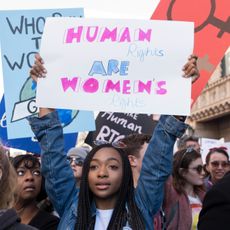 36 Ways Women Still Aren't Equal to Men
36 Ways Women Still Aren't Equal to MenFeatures It's just one of the many ways women still aren't equal to men.
By Brooke Knappenberger Last updated
-
 EMILY's List President Laphonza Butler Has Big Plans for the Organization
EMILY's List President Laphonza Butler Has Big Plans for the OrganizationUnder Butler's leadership, the largest resource for women in politics aims to expand Black political power and become more accessible for candidates across the nation.
By Rachel Epstein Published
-
 Want to Fight for Abortion Rights in Texas? Raise Your Voice to State Legislators
Want to Fight for Abortion Rights in Texas? Raise Your Voice to State LegislatorsEmily Cain, executive director of EMILY's List and and former Minority Leader in Maine, says that to stop the assault on reproductive rights, we need to start demanding more from our state legislatures.
By Emily Cain Published
-
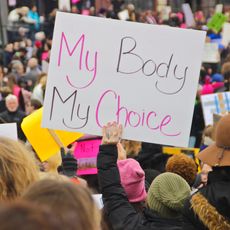 Your Abortion Questions, Answered
Your Abortion Questions, AnsweredHere, MC debunks common abortion myths you may be increasingly hearing since Texas' near-total abortion ban went into effect.
By Rachel Epstein Published
-
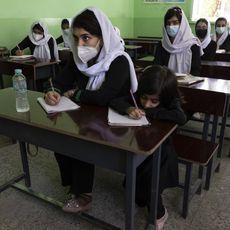 The Future of Afghan Women and Girls Depends on What We Do Next
The Future of Afghan Women and Girls Depends on What We Do NextBetween the U.S. occupation and the Taliban, supporting resettlement for Afghan women and vulnerable individuals is long overdue.
By Rona Akbari Published
-
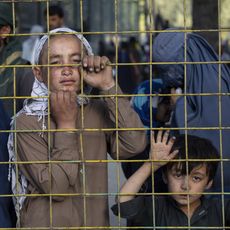 How to Help Afghanistan Refugees and Those Who Need Aid
How to Help Afghanistan Refugees and Those Who Need AidHow To With the situation rapidly evolving, organizations are desperate for help.
By Katherine J. Igoe Published
-
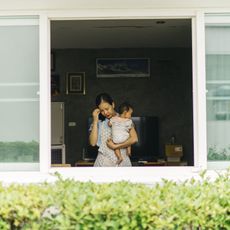 It’s Time to Give Domestic Workers the Protections They Deserve
It’s Time to Give Domestic Workers the Protections They DeserveThe National Domestic Workers Bill of Rights, reintroduced today, would establish a new set of standards for the people who work in our homes and take a vital step towards racial and gender equity.
By Ai-jen Poo Published
-
 The Biden Administration Announced It Will Remove the Hyde Amendment
The Biden Administration Announced It Will Remove the Hyde AmendmentThe pledge was just one of many gender equity commitments made by the administration, including the creation of the first U.S. National Action Plan on Gender-Based Violence.
By Megan DiTrolio Published